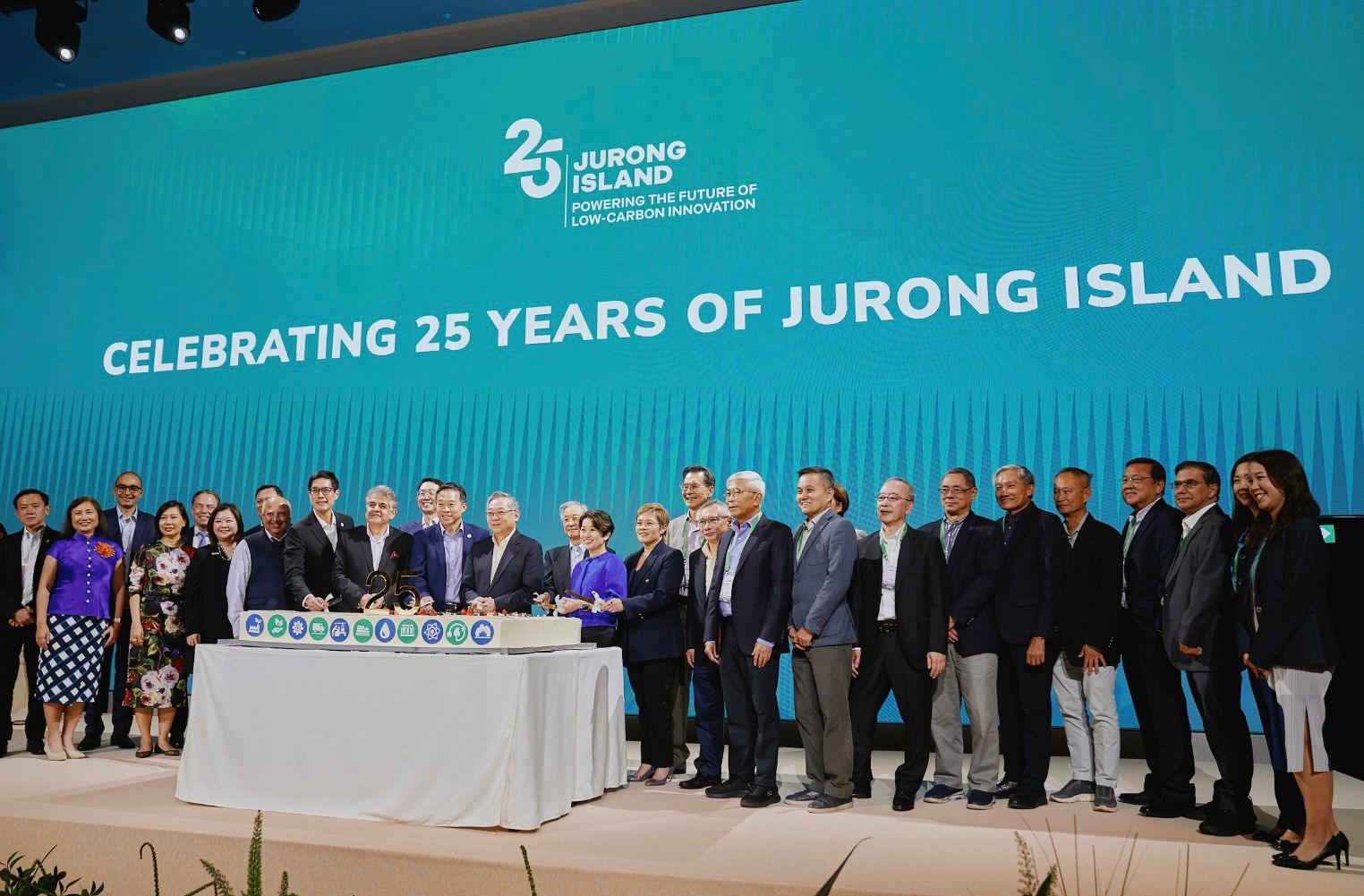For the very first time, 51 companies including Chevron, ExxonMobil and Shell are jointly supporting a circular economy study to share data on energy, water and chemical waste, and identify potential synergies to reduce resource use at the system-level. Led by JTC, the Jurong Island Circular Economy (JICE) Study builds on the concept of resource optimisation, with a goal towards longer term sustainability. As an integrated ecosystem for the energy and chemicals industry, this is not a new concept to Jurong Island. Companies on the island are today linked via pipelines that facilitate the transport and exchange of materials such as the supply of feedstock and utilities between companies. Companies also share infrastructure and third-party utilities such as co-generation power plants, storage facilities, and terminals and jetties, enabling them to benefit from greater economies of scale and resource efficiencies. But the JICE Study aims to push this further, to achieve greater optimisation of resources and harness by-products for re-use.
The launch of the JICE Study in 2019 is a milestone event, as it seeks to go beyond the efforts of individual companies to identify how an island-wide business community can bring about new opportunities to aggregate and share resources, cut back on their usage, and recover higher volumes of resources from waste for reuse. Led by JTC, the study saw strong support from multiple agencies including the Agency for Science, Technology and Research (A*STAR), Economic Development Board (EDB), Energy Market Authority (EMA), National Environment Agency (NEA) and National Water Agency (PUB).
The key findings have shown clear opportunities for greater collaborations in view of Jurong Island’s goal to transform into a sustainable energy and chemicals park, in line with the Singapore Green Plan 2030. They include:
- Greater use of cleaner energy and exploration of new technologies. Solar energy generation on the island can be scaled-up and an island-wide smart grid or network of smart grids can coordinate conventional and renewable energy generation to better optimise energy supply. R&D projects on cleaner energy technologies can also reduce the overall carbon footprint of the island. In addition, there is potential to pursue the use of cold energy for the Jurong Island ecosystem. These opportunities will allow companies on Jurong Island to increase their clean energy mix.
- Maximise water recycling and recovery. To reduce water lost through evaporation during cooling processes, companies can explore a closed-loop freshwater cooling network using seawater for indirect cooling. Companies can also explore directing their liquid waste streams to a centralised recovery facility for aggregation to reap economies of scale and promote further recycling or deploy energy-efficient water recycling technologies, reducing their water usage across the island.
- More sustainable recovery and treatment of chemical waste. There are opportunities to explore greater recovery of resources or energy from companies’ chemical waste by working with research institutes to develop and testbed more sustainable waste treatment and recovery technologies.
“ExxonMobil is committed to operating our business in a responsible and sustainable manner. This applies to our operations on Jurong Island where we strive to be the best-in-class for energy efficiency, while reducing waste as we produce useful products required by society. The Jurong Island ecosystem allows companies to work synergistically to progress technologies to reduce emissions and waste, while ensuring competitiveness,” said Ms Geraldine Chin, chairman and managing director, ExxonMobil Asia Pacific Pte Ltd.
While the study has identified opportunities in the areas of clean energy use, water recycling and recovery, and the sustainable recovery and treatment of chemical waste, it has also shed light on challenges faced in implementing the circularity solutions.
- In terms of clean energy, Jurong Island companies with larger roof spaces have started deploying solar panels on their roofs and the total installed solar capacity today stands at 8.1MWp, equivalent to powering 1,435 households a year. However, further innovation is needed to ramp up solar installation in areas near or within the process plants on the island. To date, we have received interest from about 20 companies to solarise their spaces, adding a potential of 9.6 MWp of installed solar capacity, equivalent to powering an additional 1,700 households a year.
- To optimise water use, all companies along the seafront that require significant cooling for their processes are already using seawater. In 2020, 6.5 million cubic metres of freshwater was recycled and 58.8 million cubic metres of freshwater was saved on Jurong Island though the use of seawater instead. This is equivalent to 26,000 Olympic-size swimming pools in a year. However, there remains challenges for companies with larger sites or those that are sited further inland to use seawater for cooling purposes. Companies are currently already making best effort to recycle and recover as much water as possible and further water recycling or recovery technologies tend to be energy-intensive. Hence, more studies need to be done to improve their energy efficiency as well as determine how the resultant waste can be best disposed of or reused.
- Finally, in the area of recovering chemical wastes, many Jurong Island companies and waste treatment companies are already extracting resources from chemical waste for reuse as much as possible, but further development of advanced technologies are required to better treat and recover resources from the remaining chemical waste streams that are of varied chemical compositions and often mixed together.
To better address the challenges, two innovation calls for sustainability solutions were also announced today, bringing together the industry, technology partners, academia and government agencies to develop and testbed new sustainability solutions on Jurong Island for the first time. Jurong Island will serve as a living testbed for innovation and model for sustainable technology adoption. JTC CEO, Mr Tan Boon Khai, said, “JTC is working with companies and stakeholders to pilot new sustainability innovations and capture opportunities in circular economy. As Jurong Island transforms into a more sustainable energy and chemicals park, it can, and will, play a leading role in spurring game-changing technologies, making it more competitive and sustainable in the long term.”
The first innovation call, the Jurong Island Innovation Challenge (JIIC), is spearheaded by JTC and Enterprise Singapore (ESG), and supported by PUB, NEA, and EDB. Launched today, the JIIC will crowdsource innovative ideas from startups and SMEs to enhance the sustainability and circularity of resources. Some of the biggest industry players on Jurong Island such as BASF, Chevron Oronite, Croda, Petrochemical Corporation of Singapore (PCS), Shell, Singapore LNG Corporation (SLNG), TP Utilities, and U&P are participating in the JIIC by coming together to submit 10 challenge statements. The challenge statements cover four key themes that will boost resource efficiency efforts: energy efficiency, emissions reduction, water management and chemical waste management. For example, Shell is further exploring innovative methods to extract valuable resources from waste and reduce the amount of waste sent for incineration, PCS is identifying cost-effective ways to treat and recycle its spent caustic, while Croda is developing solutions for water recovery from high strength wastewater.
With the Jurong Island companies coming forward to present their challenge statements, startups and SMEs that put forth proposals will gain opportunities to be exposed to, and work with large corporates. They will also receive funding support for the development of their solutions. Under the enterprise track, qualifying startups and SMEs stand to benefit from ESG’s Enterprise Development Grant, with up to 80% of the qualifying solution development costs supported. For selected challenge statements, awarded solution providers stand to benefit from up to $2 million in grant support under the National Innovation Challenge, for solution development and for industry adoption. Further details on the JIIC can be found on www.jurongislandinnovationchallenge.sg.
Said Mr Png Cheong Boon, Chief Executive Officer of ESG, “We are excited to work with JTC and the various stakeholders to drive the development of sustainable solutions for Jurong Island. Through this innovation call, startups and SMEs will have the opportunity to showcase their capabilities in addressing real-world circularity challenges, and work with prominent industry players to develop and testbed solutions for wider deployment eventually. We hope that such pilot projects help build up the track records of our startups and SMEs, and enable them to seize more opportunities in the green economy both locally and globally.” The second innovation call, Jurong Island Renewable Energy Request-for-Proposals (JI Renewable Energy RFP), is scheduled to be launched in October by JTC and EMA, with support from ESG, and will focus on test-bedding innovative energy solutions including renewable energy and energy storage systems to reduce the island’s carbon footprint. Examples may include high-efficiency solar panels and solar deployment on pipe racks and storage tanks. This follows an earlier Request-for-Information exercise which saw strong interest from the industry and research community with 39 proposals received.
The second innovation call, Jurong Island Renewable Energy Request-for-Proposals (JI Renewable Energy RFP), is scheduled to be launched in October by JTC and EMA, with support from ESG, and will focus on test-bedding innovative energy solutions including renewable energy and energy storage systems to reduce the island’s carbon footprint. Examples may include high-efficiency solar panels and solar deployment on pipe racks and storage tanks. This follows an earlier Request-for-Information exercise which saw strong interest from the industry and research community with 39 proposals received.
In addition to the two innovation calls, the Natural Gas Liquids (NGL) Extraction Facility project by SLNG and Keppel Infrastructure is another positive outcome from the JICE Study. This recent collaborative effort by the companies is a result of engagement efforts by JTC, EMA and EDB with SLNG to explore a roadmap for the utilisation of cold energy on the island. The NGL project is currently in the Front End Engineering Design phase and if successful, will enable cold energy to be harnessed efficiently from the SLNG terminal on Jurong Island and reduce its carbon footprint.

